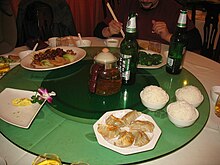Lazy Susan

A Lazy Susan is a rotating tray, usually circular, placed on top of a table to aid in moving food on a large table or countertop.
Origin
The term "Lazy Susan" made its first written appearance in a Vanity Fair advertisement for a "Revolving Server or Lazy Susan" in 1917, although their existence dates back to the 18th century. Prior to the use of the term 'Lazy Susan', they were referred to as dumbwaiters, a term today applied to a small elevator for transporting food.[1] There is no clear evidence as to the origin of the Susan part of Lazy Susan.[2]
The Lazy Susan can be made from a variety of materials, commonly plastic, wood, or glass.
The Lazy Susan could be credited to the Koreans, who used it for their movable type. Rotating it made it easier to get the characters they needed to complete a sentence or phrase.[citation needed]
Susan was the second mistress of Dr Samuel Johnson.[citation needed] She was half-mandarin through her mother and it is believed that Susan was a corruption of szechuan. When her family emigrated from the far east they were believed to have brought a rotating device with them, from which they served their daily meals. This became popular with the mandarin population of London.
Uses
The Lazy Susan is commonly used in many Chinese restaurants to facilitate dishes being ordered communally and shared[citation needed].
Other uses
This term may also refer to corner cabinets on which the shelves are mounted on a vertical axle such that items may be retrieved by pushing on the shelves to turn them. This type is usually found in kitchens. Closed, this type of Lazy Susan appears to be two normal cabinets at right angles to each other. When pushed on, the cabinet 'doors' reveal the shelves, which are circular except for the ninety degree cut-out where the doors are mounted.
Lazy Susan is also used to describe any type of small, hand-rotated flat platform, e.g. a rotating spice rack for a kitchen cabinet, a rotating TV/monitor platform, a rotating platform used to aid manual tasks like sculpture, model building, electronics repair and fabrication, etc.. A larger or motor-operated rotating platform is typically referred to as a turntable.
In the context of maintenance engineering, the term Lazy Susan may also be used to describe a device designed to aid artisans in manual activities[3] as a way of avoiding Work Related Musculoskeletal Disorders (WRMDs). The term is also used in a military context to refer to manually or electronically operated weapons turntables.[4]
In the 1982 Disney Film Herbie Goes Bananas, a lazy susan-style chassis was constructed for Herbie #14 which allowed the vehicle to rotate in a 360 Degree Turnstyle during the film's bullfighting sequence.
Certain Editions of Scrabble include a Lazy Susan in the base to facilitate turning the board to face each player.
References
- ^ "Whirling Domestics". Word-detective.com. Retrieved 2009-10-06.
- ^ "How did ''lazy Susan'' come to be used for the rotating tray?". Jewishworldreview.com. 2002-06-17. Retrieved 2009-10-06.
- ^ Fleet Readiness Center (FRC) East Uses Lazy Susan Design to Prevent Work Related Musculoskeletal Disorders
- ^ "Walker Process Turntable Bearing Is Not Just Another Lazy Susan!" (PDF). Retrieved 2009-10-06.
